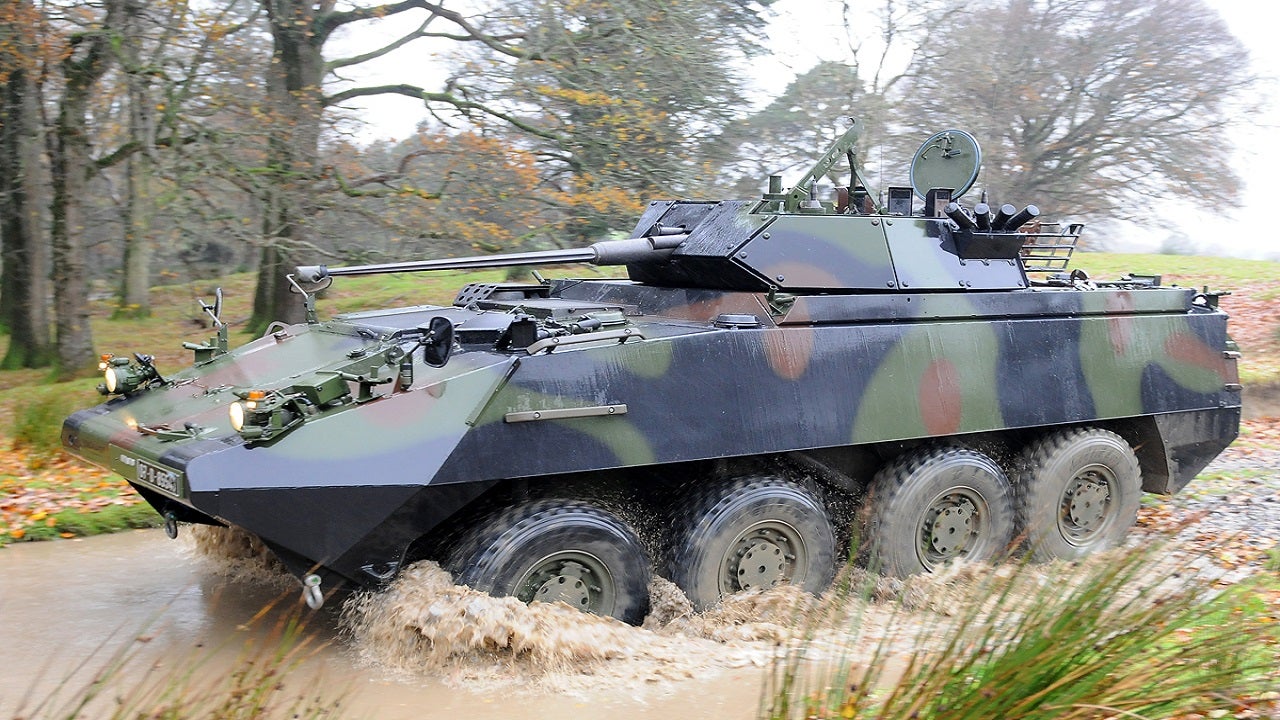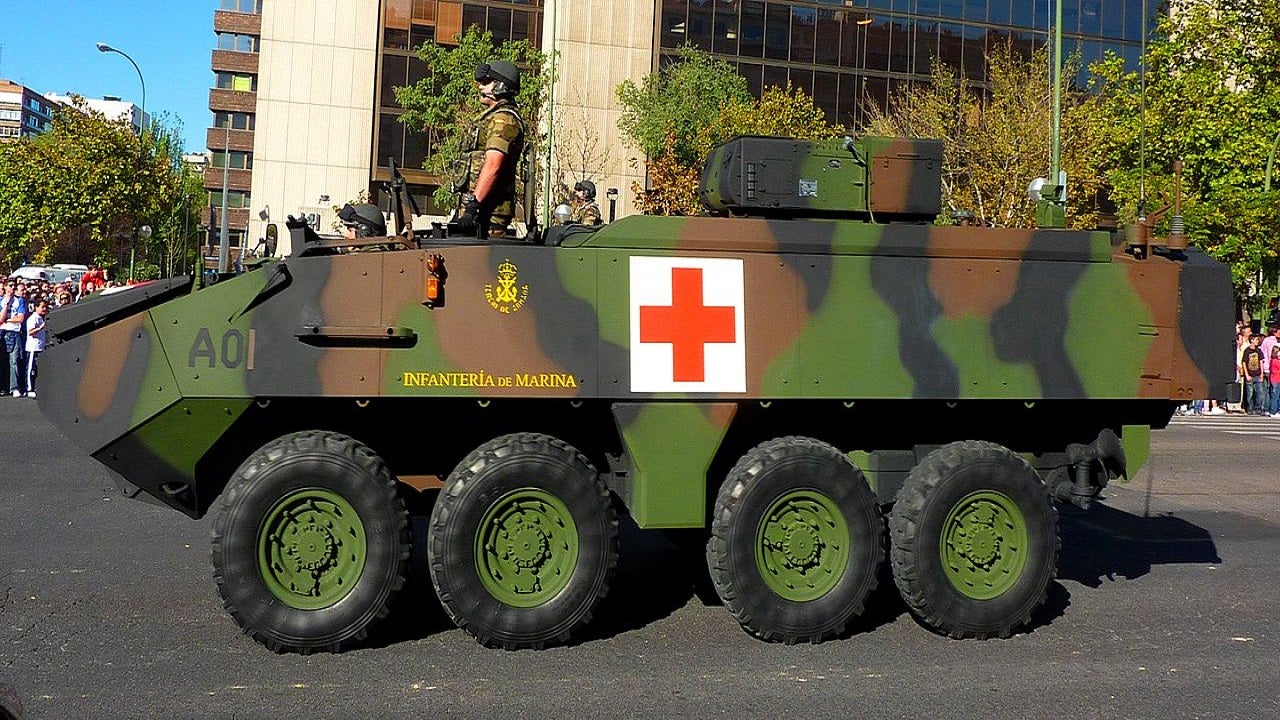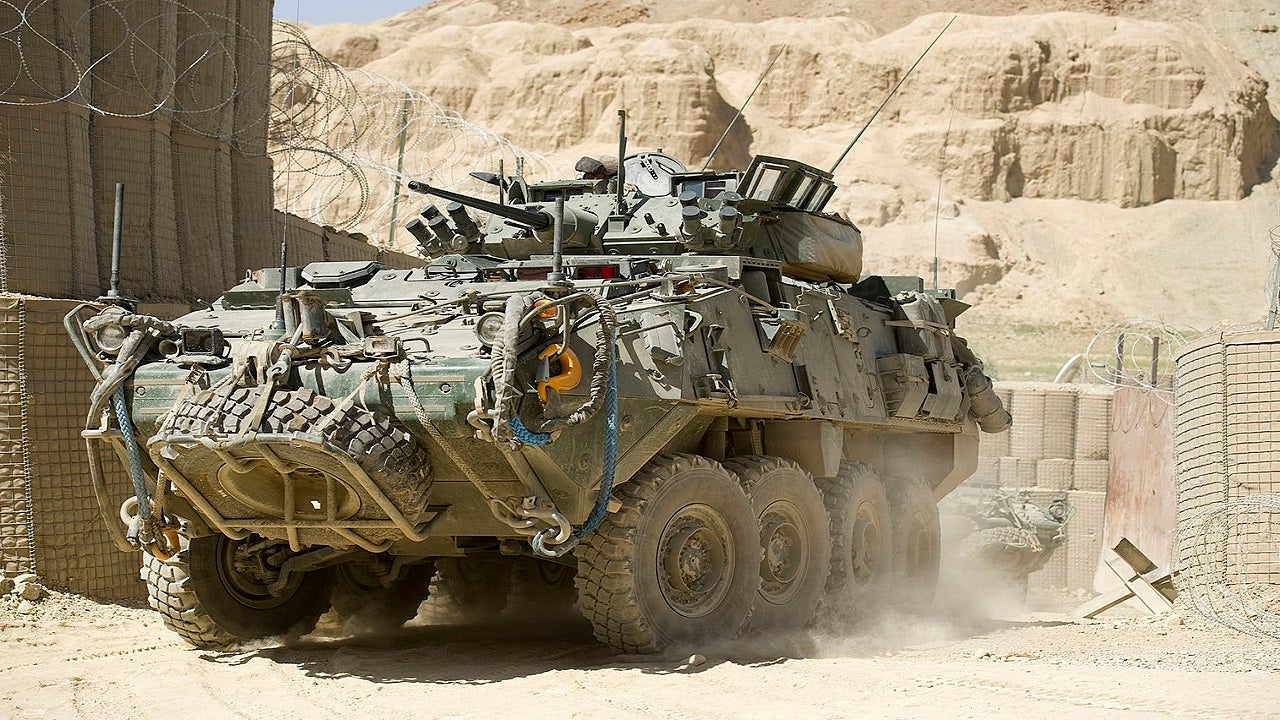PIRANHA 3 is a family of armoured wheeled vehicles developed by Mowag Motorwagenfabriken of Switzerland, now part of General Dynamics European Land Combat Systems (ELCS).
Over 8,000 PIRANHA family vehicles have been ordered and delivered. General Dynamics Land Systems – Canada (formerly General Motors Defense) also produce a version of the PIRANHA III known as the LAV 3. The vehicles are constructed in a 6×6, 8×8 and 10×10 configuration.
BAE Systems Land Systems (formerly Alvis) of the UK is also licensed for production and marketing of PIRANHA 8×8 and 10×10 light armoured vehicles. The vehicles are available as armoured personnel carrier, command vehicle, reconnaissance, fire support, repair and recovery vehicle, ambulance, mortar carrier, observation, load carrier and mortar fire control variants.
In January 2013, General Dynamics received a $65.3m contract from the Colombian Ministry of National Defence to deliver 24 LAV 3 vehicles equipped with double-V hull and add-on armour protection..
LAV 3 / Stryker 8×8 armoured vehicle
The General Dynamics Land Systems – Canada (formerly General Motors Defense) LAV 3 8×8 is in service with Canada (650 ordered) and New Zealand (NZLAV, 105 delivered between October 2003 and November 2004). The first deployment of the LAV 3 was with Canadian Forces during UN operations in Eritrea in early 2001. In October 2011, the Canadian federal government placed a $1.1bn contract with General Dynamics to upgrade 550 LAV 3 vehicles. A $133.5m modification contract was placed to upgrade 66 more LAV 3s in November 2012. The upgrades will extend the life of the fleet until 2035.
The LAV 3 forms the basis of the US Army’s interim armoured vehicle (IAV) programme and has been named the Stryker. The US Army plans to procure over 2,000 Stryker IAVs. First deliveries were in July 2002 and the vehicle entered service in November 2003.
The Stryker forms the basis of the mobile gun system which consists of a 105mm cannon mounted on a General Dynamics Land Systems (GDLS) low-profile turret integrated on the IAV. In December 2001, the US Army awarded a contract for ten Stryker mobile gun systems to GM GDLS, a joint venture between General Motors and GDLS, and the first unit was delivered in July 2002.
PIRANHA armoured vehicle family design
The third-generation PIRANHA family is based on a new lightweight hull design with increased variable ballistic protection and higher performance in terms of payload versus gross vehicle weight and increased useable internal volume.
Key design features identical throughout the family of vehicles include: power pack on the front right-hand side, central driveline system, independent wheel suspension, amphibious capability and large usable accommodation at the rear for weapon stations, equipment and troops.
PIRANHA is air transportable in a C-130 aircraft.
The PIRANHA baseline vehicles have two propellers for water propulsion with maximum speed in water of 10km/h and an amphibious kit is provided for rough seawater operations. Air-conditioning equipment includes a conditioner with 10kW cooling capacity and an Arctic heater kit for operation at temperatures below -40°C.
Armament
The PIRANHA vehicles are equipped for peace-keeping and peace-enforcing roles with a range of weapons from small-calibre turrets to a 105mm gun.
PIRANHA self-protection
Ballistic protection is provided by the application of replaceable quick-mount add-on armour packages. A mine protection kit and an NBC protection kit (either an overpressure system or a set of collective face masks) are available. Fire and explosion-suppression systems are installed on the vehicles.
In September 2007, Mowag announced that the Saab Avitronics LEDS active protection system has been integrated on a PIRANHA III vehicle. LEDS has a sensor system and dispenser for a variety of countermeasures and is effective against threats including improvised explosive devices (IEDs) and rocket-propelled grenades (RPGs).
Propulsion
The modular design allows a choice of high-performance engines and torque-matching automatic transmission. The options include:
German MTU 6V183TE22 (400hp at 2,300rpm) and ZF Ecomat 6hp 600 automatic transmission
Swedish Scania DSJ9-48A (400hp at 2,300rpm) and ZF Ecomat 6hp 600 automatic transmission
US Caterpillar 3126 (350hp at 2,500rpm) and Allison MD 3066P automatic transmission
British Cummins 6CTAA8.3-T350 (350hp at 2,200rpm) and Allison MD 3066P automatic transmission
US Detroit Diesel 6V53TA (350hp at 2,800rpm) and Allison MD 3560P automatic transmission
A hydropneumatic system which incorporates a height adjustment assembly at each wheel station, an integral central tyre inflation system (CTIS) and anti-locking brake system (ABS), a high power-to-weight ratio and the selection of the tyres to suit the type of terrain provide the high level of mobility.
PIRANHA 4
The PIRANHA 4 8×8 is another recent addition to the Piranha family of wheeled armoured vehicles. The first prototype was completed in 2001 and the second in 2004.
A range of add-on armour protection is available, including underfloor protection against mines. The upgraded MTU 544hp powerplant gives an increased power-to-weight ratio and maximum speed of 100km/h and 750km road range. PIRANHA IV is fitted with hydropneumatic suspension, ABS and a traction control system. Combat weight is up to 24t with a 10t payload and the vehicle is air transportable in C-130 aircraft.
A variety of weapon stations can be fitted and armed with 12.7mm, 25mm, 30mm or low recoil 105mm guns, including Rheinmetall Landsysteme weapon station with 12.7mm gun and Delco Systems 25mm and 30mm turrets.
BAE Systems Land Systems has been given a licence to market the PIRANHA IV in the UK and in selected other countries. Komatsu, a Japanese company, has been given a licence to manufacture the PIRANHA IV for a possible Japanese Ground Self-Defence Force (JGSDF) requirement for a wheeled armoured vehicle.
PIRANHA V
General Dynamics UK (with GDLS and Mowag) developed the next version of the PIRANHA, PIRANHA V 8×8, which has a maximum weight of about 26t. A PIRANHA Evolution demonstrator, based on elements of the PIRANHA V, took part in the Army’s medium-weight day in Warminster in September 2006.
In July 2007, PIRANHA Evolution was one of three vehicles which took part in trials (the ‘trials of truth’) for the utility variant of the UK Army’s future rapid effect system (FRES). In May 2008, General Dynamics United Kingdom Limited was selected by the UK Ministry of Defence as the provisionally preferred bidder for the utility vehicle design (UVD). This preferred status was withdrawn in December 2008.
The PIRANHA V vehicle fitted with Rheinmetall’s LANCE 30mm Modular Turret System was offered for the Canadian Close Combat Vehicle (CCV) programme in August 2011.
PIRANHA III / LAV III armoured vehicle orders PIRANHA III has been ordered by Sweden, Denmark, Ireland, Spain and Switzerland. Sweden ordered the 10×10 command vehicle and sensor vehicle for the coastal artillery; Denmark 8×8 APC; Ireland APC; and Spain 8×8 amphibious vehicles in APC, command post and ambulance variations, for deployment with the Spanish Marine Infantry.
Spanish APC vehicles have Cadillac Gage 40mm / 50-calibre turrets, an improved version of the US Marine Corps UGWS (up-gunned weapon station) with new flat roof and composite armour. Deliveries began in 2003. In January 2003 Switzerland ordered 36 radio access point (RAP) vehicles to be based on the PIRANHA III.
Denmark ordered a further 22 vehicles (11 APC, 11 ambulance) in July 2003 and another 69 in October 2004.
Ireland ordered a further 15 in January 2006, nine with the 12.7mm Kongsberg weapon station and six with an Oto Melara 30mm weapon system, to be delivered in 2007. In January 2006, Switzerland ordered eight vehicles as platforms for the integrated radio surveillance electronic warfare system. In November 2007, Switzerland ordered an additional 26 vehicles. In December 2007, Spain placed an order for 21 more vehicles in the amphibious version for the Spanish Marines.
In March 2006, Belgium awarded a contract to Mowag for the first batch of 138 PIRANHA IIIC vehicles. Total requirement is for 242 vehicles and the second, optional batch were delivered between 2012 and 2015.
The order included seven variants comprising 99 APC, 32 with the Elbit 30mm overhead weapon station, 40 with the CMI 90mm turret, 24 command post, 12 ambulance, 17 recovery and repair, and 18 engineer vehicles. The combat variants feature OIP day / night sights and laser warners and Thales communication systems.
In December 2006, Romania selected the PIRANHA IIIC and the order was placed in May 2007. The vehicles have 12.7mm unmanned turrets supplied by Elbit Systems of Israel, who provided the driver’s thermal viewer and other electro-optic systems.
The Romanian Armed Forces placed an order for the fifth batch of additional PIRANHA III 8×8 wheeled armoured vehicles in 2017.
In January 2007, the Swiss Army placed an order for the conversion of 160 PIRANHA I tank hunter vehicles to protected command vehicles. Deliveries were concluded between 2008 and 2010. The vehicles are fitted with the Kongsberg Protector remote weapon system. In December 2008, Switzerland ordered 12 PIRANHA IIIC reconnaissance vehicles in the nuclear, biological, chemical (NBC) configuration.
In September 2006 (and announced in February 2007), the Brazilian Navy ordered five PIRANHA III vehicles in the amphibious version, for the Brazilian Marines. The vehicles were delivered in 2007 and deployed to Haiti, as part of the UN mission in 2008. A further batch of five vehicles was ordered in December 2007 and 18 in November 2008.
Ministry of Defence of Botswana ordered 45 Piranha III vehicles in 2016. The country already owns a fleet of 45 Piranha IIIs.






